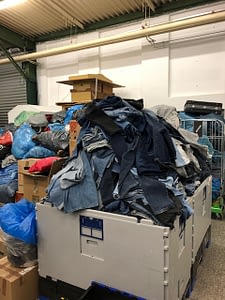The TEXTILHAFEN is a project of Berliner Stadtmission and complements the central clothing store and the neighbourhood shops. The focus here is on regional textile cycles. Sorting - sale - textile upcycling.
Which problem does the practice try to solve?
In that place clothing waste is recover, sold, re-design and sewn into new pieces
What are the solution to address the problem?
TEXTILHAFEN receives about 11 tonnes of donated clothes every week, which are sorted here. However, only a part of this is suitable for the clothing store. As a sustainable integration company, they try to give the leftover clothing a second life through various projects. Some of the cloths are sold in the second hand shop, some are repaired or up cycled. Another part is provided very day during the week for the approximately 100 homeless in the store at the main railway station.
Material pool
Another interesting project of TEXTILHAFEN is for sensible reuse is the material pool. The TEXTILHAFEN material pool has something for every textile lover. Their storage boxes are permanently filled with a wide variety of materials that can be purchased from them at a favourable price per kilo. These are items that are not suitable for use in the clothing store or for sale in our neighbourhood shops due to e.g. damage, wear marks etc. - but which are suitable for textile upcycling due to the high quality of the material.
Pop up material pool at the HdM
Another project of TEXTILHAFEN and Berliner Stadtmission is the Re-Use Centre for climate-friendly resource use is located in the House of Materialisation at Alexanderplatz. There are offers in the areas of sharing, re-use, repairing and upcycling.
What are the beneifts for the user/community?
TEXTILHAFEN is getting clothing donations (clothing waste) and bring it again in the use cycle. It offers repair workshops and place for such activities. It change the awareness for re-use and repairing among Berlin citizens.
How are CE principles addressed?
Firstly, it collects used and unwanted clothes, which are then returned to the economy in various ways. In addition, it offers various repair and up cycling layers, which not only create new products from old, but also strengthen the awareness of reusing and repairing clothes.
